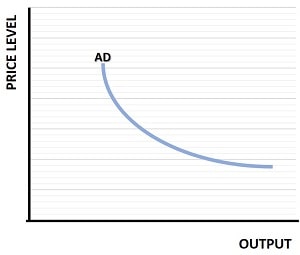- Home
- Aggregate Demand
- How to Calculate

How To Calculate Aggregate Demand
The only way how to calculate aggregate demand in an economy over a given time-period (usually a calendar year) is to add up all of the expenditures that have occurred over that time-period. The 'expenditure model' is one of three measures of national income that economists use to keep track of economic output.
The three models of national income accounting are:
- The Expenditure Approach
- The Income Approach
- The Output Approach
All three methods are used, and together they form an accounting identity:
Expenditure = Income = Output
The reason for this is that all of these methods are essentially measuring the same things but from different perspectives.
Aggregate demand calculation is, of course, subject to some error. However, these errors are relatively small, and when compared against the other measures of national income it is possible for economists to form a reasonable estimate of an economy's size, and how it has grown/shrunk over previous periods.

For a more detailed understanding of general concepts, have a look at my main article via the link:
The Aggregate Expenditure Model
You should note that the relevant expenditures are those on domestically produced goods and services, meaning that spending on imported goods, whilst constituting part of domestic aggregate demand, does not count towards domestic national income as it is actually part of another country's output. Similarly, foreigner's spending on our goods does count.
There are slightly different measures of national income definition e.g. GDP, GNP, NNP and so on that include different layers of accounting, but the basic approach is the same.
Economists do not actually calculate aggregate demand directly, except in so far as it equates to measuring national income. Instead they are interested in building theoretical models about how it interacts with aggregate supply in order that we can make better sense of related concepts like inflation and unemployment. Those related concepts are definitely measured, and form the basis of economic policy actions, which is why we need to construct theories of how these things interact.
By observing prices, output levels, and unemployment levels, we can infer (rather than calculate) where the aggregate demand and supply curves are, and how they are moving. From that, economists can form policy advice about how best to manage the economy.
Related to 'How to calculate aggregate demand'
- How do lower taxes affect aggregate demand?
- How does government spending affect aggregate demand?
- The Aggregate Demand Curve
About the Author
Steve Bain is an economics writer and analyst with a BSc in Economics and experience in regional economic development for UK local government agencies. He explains economic theory and policy through clear, accessible writing informed by both academic training and real-world work.
Read Steve’s full bio
Recent Articles
-
Energy Economics and the Slow Unraveling of the Modern West
Dec 06, 25 05:18 AM
Energy economics is reshaping global power as the West faces decline. Explore how energy, geopolitics, and resource realities drive the unfolding crisis. -
Our Awful Managed Economy; is Capitalism Dead in the U.S.?
Dec 05, 25 07:07 AM
An Austrian analysis of America’s managed economy, EB Tucker’s warning, and how decades of intervention have left fragile bubbles poised for a severe reckoning. -
The Looming Global Debt Crisis – According to Matthew Piepenburg
Dec 04, 25 02:38 PM
A deep analysis of the unfolding global debt crisis, rising systemic risks, and the coming reckoning for bonds, stocks, real estate, and the dollar. -
John Law and the Mississippi Company
Dec 02, 25 04:46 AM
The Mississippi Company shows how John Law’s monetary experiments, paper money, and credit expansion sparked rapid growth, speculation, and eventual collapse. -
Will the UK Economy Crash in 2026 because of Fiscal Illusions?
Dec 01, 25 04:52 PM
Risk of a UK economy crash is rising as debt, inflation, and weak growth collide. Explore the deep structural flaws pushing Britain toward a potential crisis.